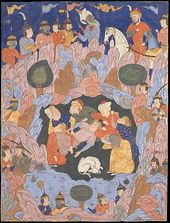From WikiIslam, the online resource on Islam
Jump to navigation
Jump to search
|
|
| Line 184: |
Line 184: |
|
| |
|
|
| |
|
| <option weight="1">{{Pictorial-Islam|1=Setting the Record Straight: The Non-Miracle of Islamic Science|2=[[File:The Miracle of Islamic Science.jpg|180px|link=Setting the Record Straight: The Non-Miracle of Islamic Science]]|3=This is a refutation of Dr K. Ajram's Setting the Record Straight: The Miracle of Islamic Science. The purpose of this analysis is to put the achievements of Golden Age Muslim scientists in the proper perspective; neither denigrating their achievements nor inflating them. All scientific and technological progress is accomplished in progression; Muslim achievements are but links in the chain. Few of the great Muslim scientific achievements stood alone, but were derived by Muslim scientists standing on the shoulders of those who came before them. This analysis also highlights the fatal flaw of the Islamic Golden Age. There were few ‘follow-up’ breakthroughs on the backs of the works of the great Muslim scientists. In effect, the Ummah allowed or encouraged these works to wither on the vine or die stillborn, even before the rise of mysticism at the expense of rational thinking, an event often attributed to al-Ghazzali around the turn of the 12th century. Indeed, it would seem orthodox Islam utterly stifles intellectual reasoning. Therefore, Islam is not the cause of scientific progress during the Golden Age. Many people would say that the Golden Age scientific progress was made in spite of Islam, not because of it. A prime example is the great philosopher-physician Ibn Sina (Avicenna) whose work is constantly referenced by Dr K. Ajram. ([[Setting the Record Straight: The Non-Miracle of Islamic Science|''read more'']])}}</option> | | <option weight="1">{{Pictorial-Islam|1=Setting the Record Straight: The Non-Miracle of Islamic Science|2=[[File:The Miracle of Islamic Science.jpg|150px|link=Setting the Record Straight: The Non-Miracle of Islamic Science]]|3=This is a refutation of Dr K. Ajram's Setting the Record Straight: The Miracle of Islamic Science. The purpose of this analysis is to put the achievements of Golden Age Muslim scientists in the proper perspective; neither denigrating their achievements nor inflating them. |
| | |
| | All scientific and technological progress is accomplished in progression; Muslim achievements are but links in the chain. Few of the great Muslim scientific achievements stood alone, but were derived by Muslim scientists standing on the shoulders of those who came before them. |
| | |
| | This analysis also highlights the fatal flaw of the Islamic Golden Age. There were few ‘follow-up’ breakthroughs on the backs of the works of the great Muslim scientists. In effect, the Ummah allowed or encouraged these works to wither on the vine or die stillborn, even before the rise of mysticism at the expense of rational thinking, an event often attributed to al-Ghazzali around the turn of the 12th century. ([[Setting the Record Straight: The Non-Miracle of Islamic Science|''read more'']])}}</option> |
|
| |
|
|
| |
|
Revision as of 22:19, 31 January 2014
Also see: Template:Pictorial-Islam
Seven Sleepers of Ephesus in the Qur'an
|
|

|
|
The legend of the Seven Sleepers of Ephesus was popular in both Europe and the Middle East during medieval times. It was translated into Latin and found its way into many Christian works of that era. The author of the Qur'an even took this story written by Christians and reworked it into a polemic against Christianity. Thus it also became very prominent in the Muslim world because of its inclusion in the Qur'an. After the Renaissance and Enlightenment of the 16th century, this story fell out of favor and was largely dismissed as mythical. Since the tale is not found in the Bible, it was also rejected by the majority of the world's Christian churches without any theological consequence. The feast day for the Seven Sleepers of Ephesus is no longer observed by the Roman Catholic Church (it is now referred to within the church as a "purely imaginative romance"), and the story today is virtually unknown among the Protestant churches. Conversely, since the tale is found within the Qur'an, Islamic apologists are forced to defend the historicity of the story. (read more)
|
|
|
